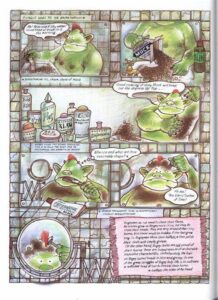Raymond Briggs, 1934-2022
by Will Morgan 24-Aug-22
Raymond Briggs, author and illustrator of the hugely popular graphic novels The Snowman, When the Wind Blows, Father Christmas and Fungus the Bogeyman, among many others, died on 9 August at the age of 88.
 A graduate of the Slade School of Fine Art, Raymond Briggs began his career in 1957 with commercial illustrations for magazines, newspapers and design studios, then in 1958 began illustrating children’s books. After having been exposed to a number of manuscripts which he regarded as sub-standard, he wrote and drew two children’s books himself, Midnight Adventure and The Strange House, in 1961. That same year, he began teaching illustration part-time at Brighton College of Art, a post he held until 1987.
A graduate of the Slade School of Fine Art, Raymond Briggs began his career in 1957 with commercial illustrations for magazines, newspapers and design studios, then in 1958 began illustrating children’s books. After having been exposed to a number of manuscripts which he regarded as sub-standard, he wrote and drew two children’s books himself, Midnight Adventure and The Strange House, in 1961. That same year, he began teaching illustration part-time at Brighton College of Art, a post he held until 1987.
In 1963 he married the painter Jean Taprell Clark, who died from leukaemia in 1973. Clark’s demise, and the deaths of his parents, compelled Briggs to seek solace in his work, and in 1973, Father Christmas—which would now be called a graphic novel, though the term had not then been coined—about a grumbling, discontented and occasionally crude Santa Claus, was released to great acclaim.
 His 1977 release Fungus the Bogeyman pushed the toilet-humour motif further, wryly enjoyed by adults for the character’s outspoken impatience and gleefully received by children who enjoyed the poo and snot jokes.
His 1977 release Fungus the Bogeyman pushed the toilet-humour motif further, wryly enjoyed by adults for the character’s outspoken impatience and gleefully received by children who enjoyed the poo and snot jokes.
His most famous work came in 1978 with The Snowman, a fable about a young boy’s snowman coming to life and taking him on adventures. Adapted (and expanded) to film in 1982, the book and film were hugely popular, and the song composed for the film, ‘Walking In The Air’, has become part of the British cultural consciousness and a Yuletide standard ever since. The story’s status as an unstoppable commercial juggernaut is attested to by the frequency with which it is parodied in other media, as is its universal familiarity to the British audience, many of whom are unaware that it was originally a graphic novel.
Perhaps his most controversial work was 1982’s When The Wind Blows, his depiction of an elderly couple’s attempts to follow woefully inadequate governmental directives after a nuclear attack; the quiet but ultimately futile courage of the protagonists in the face of utter devastation, and their determination to ‘Keep Calm and Carry On’, having faith that things will get better, is naïve, but nevertheless heartrending.
Other notable works include The Tin-Pot General and the Old Iron Woman, 1984’s roman à clef about Margaret Thatcher and General Galtieri, and Ethel & Ernest (1998), a pictorial biography of his parents’ courtship and lives, from their first meeting in 1928 to their deaths in 1971. His final book, 2019’s Time For Lights Out, was intended as exactly that; a final act, and an exploration of ageing, mortality and facing the end of life.
Many of Briggs’ works were adapted for stage, TV and radio, with the artist frequently taking active interest in the production process. He will be remembered not only for his success, or for the range and emotional depth of his stories, but for having introduced generations of adults to reading ‘graphic novels’—even if they didn’t realise it—long before the much-ballyhooed late-80s onset of Watchmen, et al.
He is survived by the adult children of his long-term partner, Liz Benjamin, who predeceased him in 2015.
Tags: Ethel & Ernest, Father Christmas, Fungus the Bogeyman, Raymond Briggs, The Snowman, UK Comics, When the Wind Blows